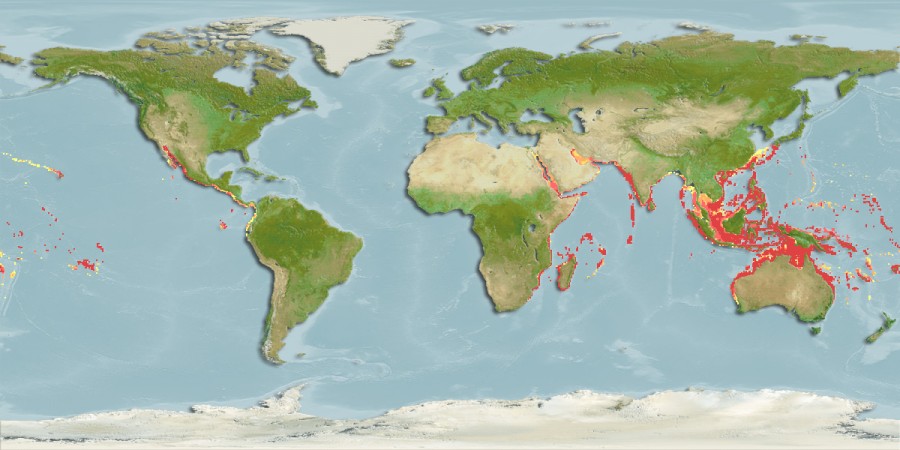Can you figure out what this is?
- Thread starter cranberry
- Start date
snakeblitz33
Well-Known Member
Short finned turkeyfish?
snakeblitz33
Well-Known Member
Dendrochirus brachypterus (Cuvier, 1829)
Shortfin turkeyfish
Upload your photos and videos
| All pictures | Google image |

Dendrochirus brachypterus
Picture by Petrinos, C.
 Play video
Play video | Native range | All suitable habitat | PointMap | Year 2050 |
 This map was computer-generated and has not yet been reviewed.
This map was computer-generated and has not yet been reviewed.AquaMaps Data sources: .s=0&c[0].p=0&c[0].o=Dendrochirus%20brachypterus&c[1].s=28&c[1].p=0&c[1].o=0]GBIF OBIS
Classification / Names
Actinopterygii (Ray-finned fishes) > Scorpaeniformes (Scorpionfishes and flatheads) > Scorpaenidae (Scorpionfishes or rockfishes) > Pteroinae
Common names | Synonyms | Catalog of Fishes (gen., sp.) | ITIS | CoL
/>
Main reference
Eschmeyer, W.N. 1986. (Ref. 4313)
Other references | Biblio | Coordinator | Collaborators
Size / Weight / Age
Max length : 17.0 cm TL male/unsexed; (Ref. 9710)
Environment
Marine; reef-associated; depth range 0 - 68 m (Ref. 37816)
Climate / Range
Tropical; 32°N - 32°S
Distribution
Indo-West Pacific: Red Sea and East Africa to Samoa and Tonga, north to southern Japan, south to Lord Howe Island; Mariana Islands in Micronesia; the Arafura Sea (Ref. 9819) and Australia.
ochirus brachypterus">Countries | FAO areas | Ecosystems | Occurrences | Introductions
Short description
Dorsal spines (total): 13; Dorsal soft rays (total): 9-10; Anal spines: 3; Anal soft rays: 5 - 6. Body reddish with vague broad bars; paired fins with bars; median fins with small dark spots (Ref. 4313). Mid-dorsal spines shorter than body depth (Ref. 37816).
Biology
Glossary (e.g. epibenthic)
Common in reef flats and shallow lagoons, in areas with weed-covered rocks on sandy substrates. Adults often found on sponges and juveniles are sometimes found in small aggregations on remote bommies with 10 or so individuals (Ref. 48635). Nocturnal. Feeds on small crustaceans (Ref. 37816).
snakeblitz33
Well-Known Member
Dendrochirus brachypterus or the Hawaiian lionfish is a lionfish endemic to the Hawaiian Islands. It has been found as far away as Johnston Atoll. It occasionally makes its way into the aquarium trade. It grows to a size of 17cm in length.
Same thing, different name, neh?
Same thing, different name, neh?
snakeblitz33
Well-Known Member
You make it too easy. 
snakeblitz33
Well-Known Member
Lol, I thought it was a game. I just did another one just like it in the "reef tanks" forum to see if anyone could guess it. HAHAHA
You pronounced it right though, as far as my limited knowledge of Latin goes.
You pronounced it right though, as far as my limited knowledge of Latin goes.
fmarini
Member
snakeBlitz33-
just to clarify, and i don't like the use of common names for identifying fish. But in general terms- the hawaiian lionfish, is NOT describing D brachypterus, and D brachypterus is not commonly found in the hawaiian islands.
D brachypterus is the name usually associated w/ "dwarf fuzzy lionfish", the scorpaenidae found Indo-West Pacific: Red Sea and East Africa to Samoa and Tonga, north to southern Japan, south to Lord Howe Island; Mariana Islands in Micronesia; as fishbase.org cites.
D barberi or the hawaiian lionfish is endemic to the hawaiian islands, looks somewhat similar to D brachypterus, and is usually associated w/ the common name you used above. Just to throw more confusion onto this pile, this common name "hawaiian lionfish" is also be used for Pterois sphex --another hawaiian endemic lionfish, but less frequently.
just to clarify, and i don't like the use of common names for identifying fish. But in general terms- the hawaiian lionfish, is NOT describing D brachypterus, and D brachypterus is not commonly found in the hawaiian islands.
D brachypterus is the name usually associated w/ "dwarf fuzzy lionfish", the scorpaenidae found Indo-West Pacific: Red Sea and East Africa to Samoa and Tonga, north to southern Japan, south to Lord Howe Island; Mariana Islands in Micronesia; as fishbase.org cites.
D barberi or the hawaiian lionfish is endemic to the hawaiian islands, looks somewhat similar to D brachypterus, and is usually associated w/ the common name you used above. Just to throw more confusion onto this pile, this common name "hawaiian lionfish" is also be used for Pterois sphex --another hawaiian endemic lionfish, but less frequently.
